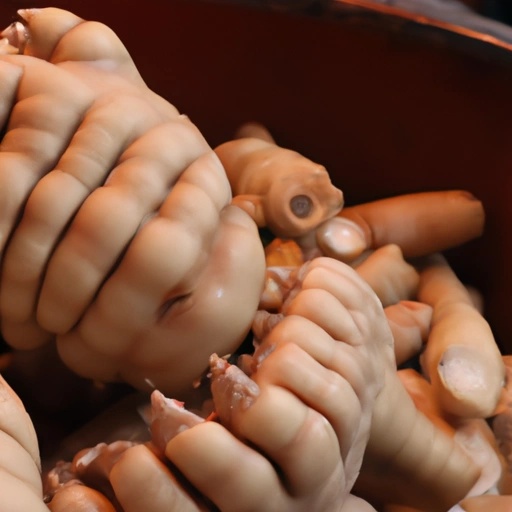Pig's Foot
Description

Pig's foot, also known as trotters, is a traditional food ingredient derived from the lower leg and foot of a pig. It has been a staple in various cultures due to its unique texture and flavor when cooked. Pig's foot can be found in a number of traditional dishes around the globe, bringing a distinctive gelatinous quality to the recipes it is used in.
Common uses
Pig's feet are commonly used to add depth and richness to soups, stews, and sauces. They are also enjoyed pickled, braised, or included in traditional dishes like jelly rolls.
Nutritional value
Calories
A 100-gram serving of cooked pig's foot contains approximately 163 calories (commonly rounded to 160 calories in some nutritional references).
Protein
Each 100 grams provides about 19 grams of protein, making it a rich source of this essential nutrient.
Fat
The fat content in pig's foot is approximately 9 grams per 100-gram serving, with a mix of saturated and unsaturated fats.
Carbohydrates
Pig's foot is low in carbohydrates, with less than 1 gram per 100 grams, as it is primarily composed of protein and fat.
Vitamins
This ingredient provides a range of B-vitamins, particularly vitamin B6 and B12, which are essential for various bodily functions.
Minerals
Pig's foot is a good source of minerals such as zinc, iron, and phosphorus, as well as being particularly high in selenium.
Health benefits
The collagen content in pig's feet may contribute to skin health and joint maintenance. Additionally, the B-vitamins and minerals found in pig's feet support metabolic processes and immune function.
Potential risks
Due to its high fat and cholesterol content, pig's foot should be consumed in moderation, particularly by individuals with dietary restrictions related to heart health. As with any animal product, there is also the risk of foodborne illness if not prepared properly.
Common recipes
Pig's feet are featured in recipes such as Spanish 'callos,' French 'pieds de cochon,' and the Korean dish 'jokbal.'
Cooking methods
Typical cooking methods include braising, boiling, stewing, and pickling. Pig's feet can also be smoked or barbecued.
Pairing with other ingredients
The rich flavor of pig's feet pairs well with acidic ingredients like vinegar or citrus, as well as with hearty vegetables like cabbage and beans.
Summary
Pig's foot is a versatile ingredient with a rich historical and cultural background. It enhances the flavor and texture of a variety of dishes while providing nutritional benefits. However, its high fat and cholesterol levels suggest it should be enjoyed in moderation. From savory stews to gelatinous terrines, pig's foot offers a unique culinary experience beloved in many parts of the world.